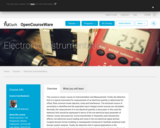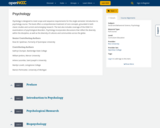
This course is a basic course on Instrumentation and Measurement. Firstly, the detection limit in a typical instrument for measurement of an electrical quantity is determined for: offset, finite common-mode rejection, noise and interference. The dominant source of uncertainty is identified and the equivalent input voltage/current sources are calculated. Secondly, the measurement of a non-electrical quantity is discussed. In this case the detection limit should be expressed in terms of the non-electrical input parameter of interest. Issues discussed are: (cross-)sensitivities in frequently used transduction effects, non-electrical source loading and noise in the non-electrical signal domain. Coupled domain formal modeling is subsequently introduced to facilitate analytical multi-domain system analysis. Finally, the detection limit in typical applications in the mechanical, thermal, optical and magnetic signal domain are analysed, along with circuit and system techniques to maximize overall system detectivity.
- Subject:
- Electrical engineering
- Engineering
- Material Type:
- Full Course
- Provider:
- Delft University of Technology
- Provider Set:
- Delft University OpenCourseWare
- Author:
- K.A.A. Makinwa
- Date Added:
- 02/08/2016

